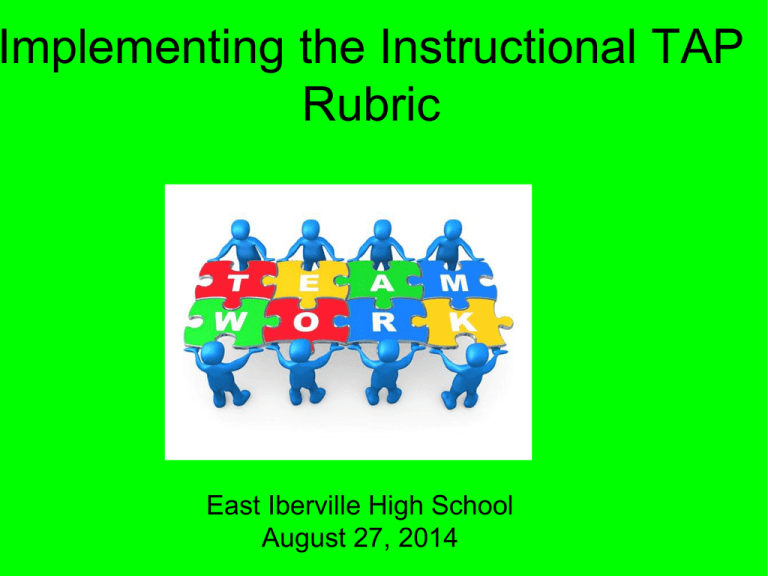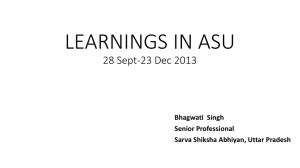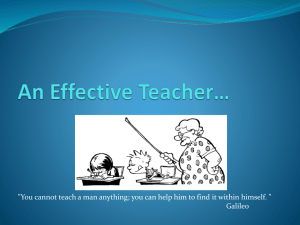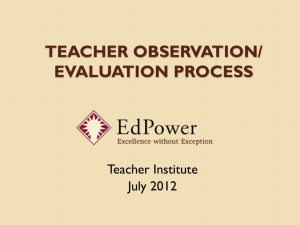Implementing the Instructional TAP Rubric
advertisement

Implementing the Instructional TAP Rubric East Iberville High School August 27, 2014 Master – Dr. Laura Nelson Mentor – Susan Burch Jamesina Collins Theresa Jones Kanavis Egland Solomon Lee Genesia Emery Karen Love Ronald Grace Katherine Mencos Lenell Osborne Delores Pointer Erin Ragsdale Dominique Ricks Nora Saari Douglas Schultz John Young Brain Teaser (Hook) There are three teachers. Their names are Mr. Jones, Mr. Smith, and Mr. Johns. Each teacher has a favorite student. The students' names are Nathan, Bob, and Jim. Each teacher is a certain age. The ages are 30, 35, and 40. Your job is to find out how old each teacher is, and find out who their favorite student is. Clue 1: The oldest teacher likes Bob the most. Clue 2: Mr. Jones is not the oldest or the youngest teacher. Clue 3: Mr. Jones does not like Nathan. Clue 4: Mr. Smith is not the oldest teacher. Cluster’s Preview Cluster Objective: By the end of the cluster meeting, Career Teachers will be able to text render key descriptors for the TAP Instructional Rubric, resulting in making connections with TAP and key elements of their content, as measured by teacher observation and TAP Instructional Rubric. NEED: Career Teachers need to make connections with the TAP rubric and key elements of your content. Career Teachers need to understand how critical elements of your content can be integrated into the TAP rubric cycle. Career Teachers need to understand how both initiatives together impact student achievement. NEW LEARNING: Master Teacher will model how to text render the first six descriptors for the TAP Instructional Rubric focusing on Standards and Objectives. Master Teacher and Career Teachers will text render the key descriptors for the TAP Instructional Rubric focusing on Motivating Students. DEVELOPMENT: APPLICATION: Career Teachers will text render the key descriptors for the TAP Instructional Rubric focusing on Lesson Structure and Pacing. Career Teachers will in pairs to text render specific TAP Indicators and apply all Indicators in your daily lessons. EVALUATION: Career Teachers will bring back student evidence that most students demonstrate mastery of the objective under the Standards and Objectives Indicator. Cluster Long Range Plan August 26, 2014 September 3, 2014 September 10, 2014 By the end of the cluster meeting, Career Teachers will be able to text render key descriptors for the TAP Instructional Rubric, resulting in making connections with TAP and key elements of their content, as measured by teacher observation and TAP Instructional Rubric. Outcome By the end of the cluster meeting, Career Teachers will be able understand the TAP Designing and Planning Rubric and the Learning Environment Rubric, resulting in making connections with TAP and key elements of their content, as measured by teacher observation and TAP Instructional Rubric. By the end of the cluster meeting, Career Teachers will be able to identify the Depth of Knowledge (Thinking) required to answer a question, so that teachers will know what level they are currently teaching, as measured by short answer items. Cluster Meeting • By the endOutcome of the cluster meeting, Career Teachers will be able to text render key descriptors for the TAP Instructional Rubric, resulting in making connections with TAP and key elements of their content, as measured by teacher observation and TAP Instructional Rubric. What is text rendering? What is text rendering? • To construct meaning collaboratively, clarify, and expand our thinking about a shared text • During the process, participants will choose one or two sentences, one phrase, and one word that they found most important. I Do: I will model how to text render the first six descriptors for the TAP Instructional Rubric focusing on Standards and Objectives. Standards and • Most learning objectives and state content Objectives: standards are communicated. • • • • • Sub-Objectives are mostly aligned to the lesson’s major objective. Learning Objectives are connected to what students have previously learned. Expectations for student performance are clear. State standards are displayed. There is evidence that most students demonstrate mastery of the objective. We Do: We will text render the key descriptors for the TAP Instructional Rubric focusing on Motivating Students. Motivating Students • The teacher sometimes organizes the content so that it is personally meaningful and relevant to students. • The teacher sometimes develops learning experiences where inquiry, curiosity and exploration are valued. • The teacher sometimes reinforces and rewards effort. You do: You (with our assistance) will text render the key descriptors for the TAP Instructional Rubric focusing on Lesson Structure and Pacing. Lesson Structure and Most lessonsPacing: start promptly The lesson’s structure is coherent, with a beginning, middle, and end. Pacing is appropriate, and sometimes provides opportunities for students who progress at different learning rates. Routines for distributing materials are efficient. Little instructional time is lost during Partner up: Partner up with the person that has the same number as you. Your Job: Text render the given Indictor together Post responses on a Post-It Report Out/Share out Evaluate You will apply what you have learned pertaining to the “Big 12” into your daily lessons. You will bring back evidence that most students demonstrate mastery of the objective under the Standards and Objectives Indicator. Exit Ticket Follow-up/Support Schedule Burch, Susan Collins, Jamesina Egland, Kanavis Emery, Genesia Grace, Ronald Jones, Theresa Follow-up/Support Schedule Lee, Solomon Love, Karen Mencos, Katherine Osborne, Lenell Pointer, Delores Ragsdale, Erin Follow-up/Support Schedule Ricks, Dominique Picard, Richard Saari, Nora Schultz, Douglas Warren, Tracy Young, John







